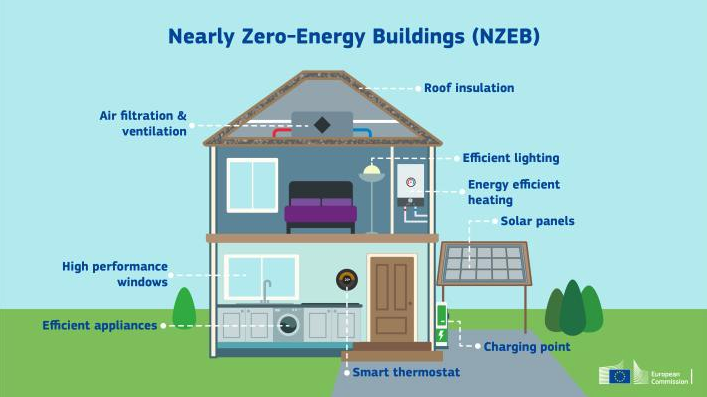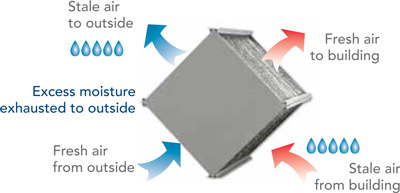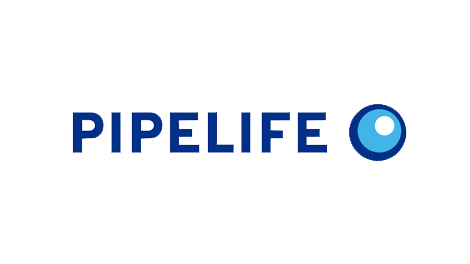PIPELIFE – Exploring Energy-Efficient HVAC Alternatives
 HVAC, or heating, ventilation, and air conditioning, is a critical aspect of building design and construction.
HVAC, or heating, ventilation, and air conditioning, is a critical aspect of building design and construction.
HVAC systems regulate indoor temperature, humidity and air quality to ensure comfortable and healthy environments for occupants.
However, since HVAC systems arguably make the largest contribution to worldwide building energy consumption, there is a growing demand for sustainable HVAC solutions, including energy-efficient alternatives to conventional systems.
THE NEED FOR SUSTAINABLE HVAC SOLUTIONS
According to the European Commission, buildings are responsible for 40% of energy consumption in the EU. Moreover, it is suggested that, on average, HVAC systems account for 38% of building energy consumption, which amounts to 12% of global energy use.
In this context, it is unsurprising that governments, political institutions and building regulators are increasingly concerned with the energy efficiency of buildings and their HVAC systems.
Since 2020, the European Commission has been implementing the European Green Deal in an attempt to make the European Union climate neutral by 2050. The Green Deal is a set of policy initiatives that aim to boost the energy-efficient use of resources and move Europe towards a clean, circular economy.
For example, the Energy Performance of Buildings Directive required EU member states to legislate the need for all new buildings to be nearly zero-energy buildings (NZEB) by 2021, and all new public buildings to be NZEB by 2019.
Major building certification schemes, such as BREEAM, LEED, and DGNB, are also concerned with the energy efficiency of new buildings for similar reasons. Buildings seeking certification must meet specific criteria related to energy performance, including the sustainability and efficiency of their HVAC systems.
MOVING TOWARDS ENERGY-SAVING SYSTEMS
Traditional methods of heating, air conditioning, and ventilation have long been associated with high energy consumption and uneven temperature distribution. Along with an evolving policy landscape, these inefficiencies have left building owners, developers and occupants keen to explore energy-efficient HVAC alternatives.

.jpg)
HEATING
Heating setups often rely on radiators or forced-air appliances that heat spaces unevenly and require relatively high temperatures to achieve comfortable indoor environments.
In the search for an energy-efficient alternative to traditional setups, hydronic heating systems have become increasingly popular. Hydronic systems are water-based and benefit from a comprehensive design that enables even heating of both small and large spaces.
Instead of air, hydronic systems regulate indoor temperatures by circulating hot water through pipes that run underneath the floor or are embedded in walls. Their superior energy efficiency lies in their ability to produce radiant heat that achieves optimal thermal comfort at lower temperatures than traditional appliances. For example, occupants with a forced-air system may require an indoor temperature of 22 °C to feel comfortable. However, with a hydronic system, they could achieve the same feeling of thermal comfort at 20 °C.
These low operating temperatures further increase the efficiency of hydronic systems as they enable easy integration with sustainable systems and energy sources, such as solar, geothermal and heat pumps.
Finally, their versatile design facilitates comprehensive coverage of large surface areas. They can be implemented underneath the entirety of a floor or wall, as opposed to a single corner, to ensure that all of the space experiences equal thermal radiation, avoiding the hot and cold spots associated with conventional systems.
.jpg)
.jpg)
AIR CONDITIONING
Conventional forced-air conditioning units struggle with the same inefficiencies as their heating counterparts. The inefficiency of air as a thermal conductor means that they require vast amounts of energy to bring the temperature of a room down to a comfortable level.
Moreover, air conditioning units are typically oversized as homeowners often opt for larger units in the belief that they will provide better cooling. This misconception leads to frequent cycling that causes units to operate inefficiently, generate higher electricity bills, and wear out faster.
The constant cycle of cooling and dehumidifying air can also result in uneven temperatures, drafts and fluctuating humidity levels in a space, leading to uncomfortable living and working environments.
Additionally, air conditioning systems often rely on ductwork, which can be prone to leaks, heat loss and bacteria growth if not regularly maintained.
As with heating, hydronic systems can provide an energy-efficient cooling alternative to air conditioners. Hydronic cooling systems also use water to regulate the temperature of a room by running cold water throughout a pipe network.
While less suitable for underfloor applications, hydronic cooling systems work well in walls and offer particular efficiency advantages when installed in ceilings. Ceiling integration ensures the most even cooling throughout the entirety of a room.
Set up in this way, hydronic cooling systems offer the same energy-efficiency benefits: they require less energy to bring down the temperature of a room, are suitable for renewable energy integration, and provide even coverage throughout large spaces. They can also be installed as a combined system to provide both heating and cooling, ensuring comfortable living environments throughout the year.
.jpg)
.jpg)
VENTILATION
While hydronic systems offer an energy-efficient solution for indoor temperature management, it is important to note that these systems do not replace the need for proper ventilation. Ventilation is crucial for maintaining good indoor air quality and ensuring the health and well-being of occupants — especially in modern, passive houses.
The energy efficiency of ventilation solutions can be improved with the incorporation of systems such as Heat Recovery Ventilators (HRV) and Energy Recovery Ventilators (ERV). Both HRVs and ERVs work by transferring heat energy between incoming fresh air and outgoing stale air. While HRVs focus on heat exchange, ERVs also transfer moisture to regulate indoor humidity levels. These systems reduce the energy required for heating or cooling the incoming fresh air, leading to significant energy savings and improved indoor air quality.
Alternatively, earth tubes, or indirect earth coupling, can offer a passive approach to ventilation. Earth tubes utilize the stable temperature of the ground to condition fresh air before it is circulated throughout a building. This involves burying a network of pipes several meters underground, where the temperature is relatively constant.
As the outside air is drawn through the buried tubes, it exchanges heat with the surrounding soil before entering the building. Earth tubes can reduce the need for active heating or cooling and therefore provide an excellent energy-saving approach to both ventilation and indoor temperature management.
Another energy-efficient ventilation strategy is the use of demand-controlled ventilation (DCV) systems. DCV systems use sensors to monitor indoor air quality and adjust the ventilation rate based on factors such as occupancy, carbon dioxide levels, or other air pollutants. By only providing fresh air when it is required, DCV systems can significantly reduce energy consumption while maintaining a healthy indoor environment.
EMBRACING ENERGY-EFFICIENT HVAC SOLUTIONS FOR A SUSTAINABLE FUTURE
With the global focus on reducing carbon emissions and achieving climate neutrality, it is crucial that we explore and implement energy-efficient HVAC alternatives in our homes and buildings. The integration of hydronic systems with renewable energy sources, as well as the adoption of advanced ventilation solutions, demonstrates the potential for creating sustainable, energy-efficient buildings that align with the goals of the European Green Deal and other global initiatives.
By prioritizing efficiency in the design, construction, and operation of our buildings, we can contribute to global efforts against climate change while ensuring the well-being and comfort of occupants. The time has come to invest in sustainable HVAC solutions that will shape the future of our built environment.
Source
PIPELIFE INTERNATIONAL GMBH
EMR Analysis
More information on Pipelife: https://www.pipelife.com + Pipelife is a leading international manufacturer of sustainable piping solutions that connect people and communities with water, energy and data. Our purpose is to provide the necessary means of infrastructure to create a safer, healthy and more carefree living for current and future generations. Whether behind walls, in floors, underground, or at the bottom of the sea, our solutions may be hidden but they are always part of your life.
Pipelife was founded in 1989 as as a joint venture of Solvay (Belgium) and Wienerberger (Austria) with activities in Austria, France and Germany. Since 2012, Pipelife is fully owned by Wienerberger.
Pipelife was founded in 1989, as a joint venture of Solvay (Belgium) and Wienerberger (Austria). Since 2012, Pipelife is fully owned by Wienerberger, with our headquarters based in Vienna, Austria. We are actively present in 24 countries with 3,756 employees. As of 2022, 855,608 km of our pipes have been installed. That’s more than 21 times around the world!
More information on Wienerberger: https://www.wienerberger.com/en.html + The Wienerberger group operates 216 production sites in 28 countries and is the world’s largest producer of bricks and the market leader in clay roof tiles in Europe as well as concrete pavers in Central-Eastern Europe and pipe systems in Europe.
- 216 Plants
- 19,000 Employees
- 28 Countries
Wienerberger AG is a public company on the Vienna Stock Exchange. There is no single, main shareholder, as all shares are free float shares. The majority of shares are held by institutional investors, with less than 15% owned by private investors.
Wienerberger’s brands are: Wienerberger (Clay Blocks, Facing Bricks and Clay Toof Tiles), Pipelife (Plastic Pipes for transporting energy, water and data) Steinzeug-Keramo (Solutions for Sewer Systems, Pipes for open and sealed designs), Semmelrock (Concrete pavements in Central and Eastern Europe) and General Shale (Facing Bricks in the USA and Canada)
More information on Harald Schwarzmayr (CEO, Pipelife + COO, Wienerberger AG): See the full profile on EMR Executive Services
More information on The European Union: https://european-union.europa.eu/index_en + The European Union’s institutional set-up is unique and its decision-making system is constantly evolving. The 7 European institutions, 7 EU bodies and over 30 decentralised agencies are spread across the EU. They work together to address the common interests of the EU and European people.
In terms of administration, there are a further 20 EU agencies and organisations which carry out specific legal functions and 4 interinstitutional services which support the institutions.
All of these establishments have specific roles – from developing EU laws and policy-making to implementing policies and working on specialist areas, such as health, medicine, transport and the environment.
There are 4 main decision-making institutions which lead the EU’s administration. These institutions collectively provide the EU with policy direction and play different roles in the law-making process:
- the European Parliament (Brussels/Strasbourg/Luxembourg)
- the European Council (Brussels)
- the Council of the European Union (Brussels/Luxembourg)
- the European Commission (Brussels/Luxembourg/Representations across the EU)
Their work is complemented by other institutions and bodies, which include:
- the Court of Justice of the European Union (Luxembourg)
- the European Central Bank (Frankfurt)
- the European Court of Auditors (Luxembourg)
The EU institutions and bodies cooperate extensively with the network of EU agencies and organisations across the European Union. The primary function of these bodies and agencies is to translate policies into realities on the ground.
Around 60,000 EU civil servants and other staff serve the 450 million Europeans (and countless others around the world).
Currently, 27 countries are part of the EU: https://european-union.europa.eu/principles-countries-history/country-profiles_en
More information on The European Commission: https://ec.europa.eu/info/index_en + The Commission helps to shape the EU’s overall strategy, proposes new EU laws and policies, monitors their implementation and manages the EU budget. It also plays a significant role in supporting international development and delivering aid.
The Commission is steered by a group of 27 Commissioners, known as ‘the college’. Together they take decisions on the Commission’s political and strategic direction.
A new college of Commissioners is appointed every 5 years.
The Commission is organised into policy departments, known as Directorates-General (DGs), which are responsible for different policy areas. DGs develop, implement and manage EU policy, law, and funding programmes. In addition, service departments deal with particular administrative issues. Executive agencies manage programmes set up by the Commission.
Principal roles in law: The Commission proposes and implements laws which are in keeping with the objectives of the EU treaties. It encourages input from business and citizens in the law-making process and ensures laws are correctly implemented, evaluated and updated when needed.
More information on Ursula von der Leyen (President, The European Commission): https://ec.europa.eu/commission/commissioners/2019-2024/president_en + https://www.linkedin.com/in/ursula-von-der-leyen/
More information on The EU Green Deal: https://ec.europa.eu/info/strategy/priorities-2019-2024/european-green-deal_en +
- The European Green Deal will transform the EU into a modern, resource-efficient and competitive economy, ensuring:
- no net emissions of greenhouse gases by 2050
- economic growth decoupled from resource use
- no person and no place left behind
- The European Green Deal provides an action plan to:
- boost the efficient use of resources by moving to a clean, circular economy
- restore biodiversity and cut pollution
- The plan outlines investments needed and financing tools available. It explains how to ensure a just and inclusive transition.
- The EU aims to be climate neutral in 2050. We proposed a EuropeanClimate Law to turn this political commitment into a legal obligation.
More information on the European Commission Nearly Zero-Energy Buildings (NZEB): https://energy.ec.europa.eu/topics/energy-efficiency/energy-efficient-buildings/nearly-zero-energy-buildings_en + The EU has proposed to move from the current nearly zero-energy buildings to zero-emission buildings by 2030.
Nearly zero-emission building (NZEB) means a building that has a very high energy performance, while the nearly zero or very low amount of energy required should be covered to a very significant extent by energy from renewable sources, including energy from renewable sources produced on-site or nearby.

The Energy Performance of Buildings Directive requires that EU countries had to ensure that all new buildings were nearly zero-energy by the end of 2020 while all new public buildings had to be nearly zero-energy after 31 December 2018.
More information on BREAAM Sustainability Standards: https://www.breeam.com + BREEAM is the world’s leading sustainability assessment method for masterplanning projects, infrastructure and buildings. It recognises and reflects the value in higher performing assets across the built environment lifecycle, from new construction to in-useand refurbishment.
BREEAM does this through third party certification of the assessment of an asset’s environmental, social and economic sustainability performance, using standards developed by BRE. This means BREEAM rated developments are more sustainable environments that enhance the well-being of the people who live and work in them, help protect natural resources and make for more attractive property investments.
More information on LEED Certification: https://www.usgbc.org/leed + LEED provides a framework for healthy, efficient, carbon and cost-saving green buildings. LEED certification is a globally recognized symbol of sustainability achievement and leadership.
LEED certified buildings save money, improve efficiency, lower carbon emissions and create healthier places for people. They are a critical part of addressing climate change and meeting ESG goals, enhancing resilience, and supporting more equitable communities.
To achieve LEED certification, a project earns points by adhering to prerequisites and credits that address carbon, energy, water, waste, transportation, materials, health and indoor environmental quality. Projects go through a verification and review process by GBCI and are awarded points that correspond to a level of LEED certification: Certified (40-49 points), Silver (50-59 points), Gold (60-79 points) and Platinum (80+ points).
LEED is a holistic system that doesn’t simply focus on one element of a building such as energy, water or health, rather it looks at the big picture factoring in all of the critical elements that work together to create the best building possible. In fact, 35% of the credits in LEED are related to climate change, 20% of the credits directly impact human health, 15% of the credits impact water resources, 10% of the credits affect biodiversity, 10% of the credits relate to the green economy, 5% of the credits impact community and 5% of the credits impact natural resources.
More information on the German Sustainable Building Council (DGNB): https://www.dgnb.de/en/index.php + DGNB – the abbreviation (in German) for the German Sustainable Building Council. A non-profit organisation based in Stuttgart, ever since it was founded in 2007 the DGNB has been committed to demonstrably good buildings and urban districts that are worth living in. In straightforward terms, this means building an environment around ourselves with foresight. Our overarching aim is to promote change in the building and property market, engendering an appropriate understanding of quality as a foundation for responsible and sustainable action.
The DGNB promotes sustainable building in a variety of ways, not only in Germany but also in the rest of the world.
The conceptual principles of the DGNB revolve around a holistic understanding of sustainability, encompassing environmental, economic and sociocultural factors. So our vision is just as much about the environment as it is about economic viability and people. As a consequence, for the DGNB sustainability is synonymous with quality and future viability.
More information on DGNB Certification: https://www.dgnb.de/en/council/certification/index.php + To make sustainable building applicable on a practical level, measurable and thus comparable, the DGNB has developed its own certification system. This system offers a variety of options for buildings, indoor environments and districts – not only for new buildings but also for existing ones. The DGNB System works like a planning and optimisation tool, providing help with raising the tangible sustainability of building projects. It also fosters a shared understanding of the pertinent requirements of sustainable building methods, among all parties involved in development projects. Certification should make an essential contribution to quality across the board in planning, construction and actual use. By reducing risk and the costs associated with it, applying the DGNB System helps tailor building projects to needs on the horizon. An important part of this is our independent certification process, which adds transparency to quality controls. The DGNB Certificate is granted in Platinum, Gold or Silver, so it can also be used as an award and marketing instrument. The DGNB certification system is considered the most advanced system of its kind in the world and is internationally recognised as the global benchmark for sustainability. Applied outside Germany, the DGNB System is adapted to regional requirements. To this end, the DGNB works in close partnership with leading local organisations within individual countries.
EMR Additional Notes:
- HVAC-R (Heating, Ventilation, and Air Conditioning – Refrigeration):
- Heating, ventilation, and air conditioning is the use of various technologies to control the temperature, humidity, and purity of the air in an enclosed space. Its goal is to provide thermal comfort and acceptable indoor air quality.
- HVACR involves maintaining, repairing and installing heating, ventilation, air conditioning, and refrigeration systems.
- Hydronic Heating:
- Hydronic heating uses hot water to heat your home and is one of the most efficient and versatile forms of heating. Also referred to as radiant heating, a hydronic heating system circulates heated water through sealed pipes to underfloor heating systems, trench convectors, panel radiators, or heated towel rails.
- Heat Recovery Ventilators (HRV) and Energy Recovery Ventilators (ERV):
- An HRV is a controlled ventilation system that recovers and recycles energy from an Exhaust Air Stream. In winter the HRV recovers available heated energy, and in Summer, if your home is air conditioned, the HRV recovers cooled energy.
- HRVs and ERVs are similar devices in that both supply air to the home and exhaust stale air while recovering energy from the exhaust air in the process. The primary difference between the two is that an HRV transfers heat while an ERV transfers both heat and moisture.

- Demand-Controlled Ventilation (DCV):
- Process designed to adjust/reprogram the ventilation settings within a building, based on the fluctuating occupancy. DCV systems can automatically reduce ventilation intensity during off-peak hours, saving a lot of energy in the process.
- Demand-controlled ventilation regulates the ventilation airflow rate using signals from air-pollutant sensors or occupancy sensors. CO2 sensors communicate with a control panel to regulate ventilation airflow.
- Circular Economy:
- A circular economy is a systemic approach to economic development designed to benefit businesses, society, and the environment. In contrast to the ‘take-make-waste’ linear model, a circular economy is regenerative by design and aims to gradually decouple growth from the consumption of finite resources.
- In such an economy, all forms of waste, such as clothes, scrap metal and obsolete electronics, are returned to the economy or used more efficiently.
- The aim of a circular economy is hence to create a closed-loop system where waste and pollution are minimized and resources are conserved, reducing the environmental impact of production and consumption.
- Sustainability Vs. Circular Economy:
- Circularity focuses on resource cycles, while sustainability is more broadly related to people, the planet and the economy. Circularity and sustainability stand in a long tradition of related visions, models and theories.
- A sustainable circular economy involves designing and promoting products that last and that can be reused, repaired and remanufactured. This retains the functional value of products, rather than just recovering the energy or materials they contain and continuously making products anew.

